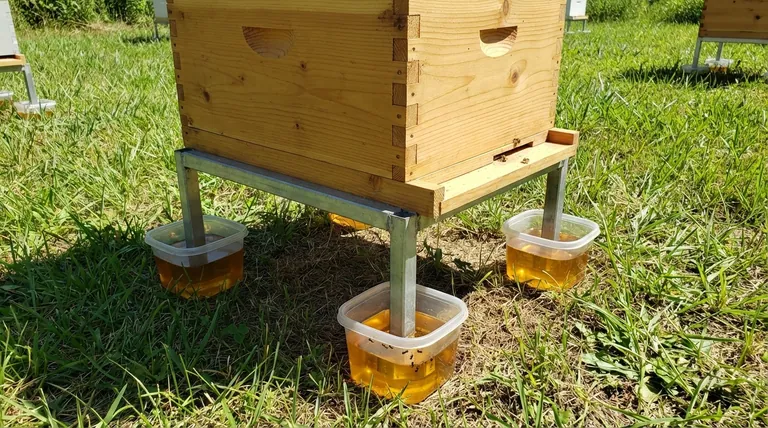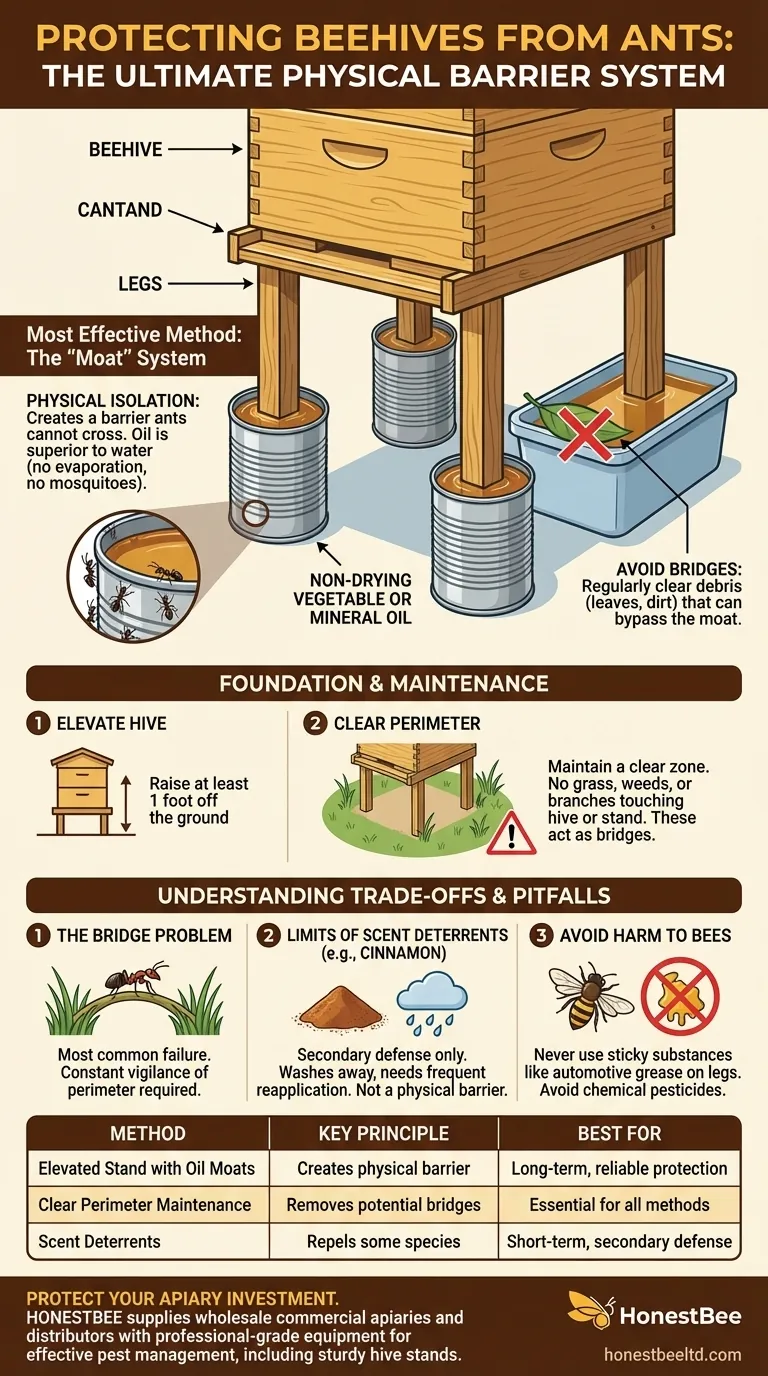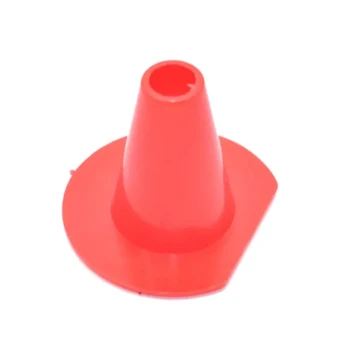The most effective way to protect a beehive from ants is to create a physical barrier using a hive stand with legs that are placed in containers of oil or water, creating a "moat" ants cannot cross. This physical isolation, combined with keeping the area around the hive clear of any vegetation that could form a bridge, is the most reliable and long-term solution.
Your primary goal is not just to repel ants, but to physically isolate the entire hive from the ground. A multi-layered defense combining an elevated hive stand, a physical barrier like an oil moat, and a clear perimeter is the only truly dependable strategy for long-term ant prevention.

The Foundation: Proper Hive Placement and Maintenance
Before considering any repellents or traps, your first line of defense is the physical setup of your hive. Getting this right solves the vast majority of ant-related issues.
Elevate the Hive
A hive sitting directly on the ground is an open invitation for ants and other pests. Using a hive stand to elevate the hive by at least a foot is the non-negotiable first step.
Clear the Surrounding Area
Ants are resourceful and will use any available path to their target. This is the single most common point of failure in any hive defense system.
You must maintain a clear zone around the hive stand, ensuring no blades of grass, weeds, or fallen branches are touching the hive or stand legs. These act as bridges, rendering all other protections useless.
The Most Effective Method: Creating a Physical Barrier
While repellents can help, a physical barrier is a far more definitive solution. The principle is simple: create something the ants cannot cross to get to the hive stand legs.
The "Moat" System
This is the industry-standard method for good reason. Each leg of the hive stand is placed inside a small, durable container (like a tin can or plastic tub).
Using Oil, Not Water
Fill these containers with a non-toxic, non-drying liquid. Vegetable oil or mineral oil is superior to water because it doesn't evaporate and won't become a breeding ground for mosquitoes. The oil creates a surface that ants cannot cross.
Inspecting Your Barriers
Regularly check that your moats have not been bridged by debris like leaves or dirt. A single leaf can defeat the entire system.
Understanding the Trade-offs and Common Pitfalls
Relying on a single technique or failing to maintain your setup can lead to infestations. Understanding the limitations of each method is key.
The Bridge Problem
As noted, the most common failure is an unintentional bridge. A tall blade of grass leaning against a hive leg is all it takes for ants to bypass even the most robust moat. Constant vigilance of the hive's perimeter is essential.
The Limits of Scent-Based Deterrents
Some beekeepers use powdered cinnamon as a deterrent, sprinkling it around the base of the hive stand.
While some ant species dislike the scent and will avoid crossing it, this is not a physical barrier. It can be effective as a secondary defense but should not be your primary one, as it washes away with rain and needs frequent reapplication.
Avoiding Harm to Your Bees
Never use sticky substances like automotive grease directly on hive legs, as bees can easily get trapped in them. Always use non-toxic substances in your moats and avoid chemical pesticides anywhere near your hives.
Making the Right Choice for Your Goal
Your approach to ant control should be proactive, not reactive. The best defense is one that is established before the ants ever find the hive.
- If your primary focus is setting up a new hive: Start with a sturdy hive stand and implement an oil moat system from day one. This is the most effective and lowest-maintenance solution.
- If your primary focus is solving an existing ant problem: Immediately inspect for and remove any bridges between the ground and the hive, then implement an oil moat system to prevent re-infestation.
- If your primary focus is a simple, bee-safe deterrent: Sprinkling cinnamon is a valid secondary tactic, but recognize its limitations and be prepared to reapply it often, especially after weather events.
A healthy colony is a protected colony, and effective pest management is a fundamental part of responsible beekeeping.
Summary Table:
| Method | Key Principle | Best For |
|---|---|---|
| Elevated Hive Stand with Oil Moats | Creates a physical barrier ants cannot cross. | Long-term, reliable protection. |
| Clear Perimeter Maintenance | Removes potential bridges (grass, debris). | Essential for all methods. |
| Scent Deterrents (e.g., Cinnamon) | Repels some ant species. | Short-term, secondary defense. |
Protect Your Apiary Investment with Professional-Grade Solutions
Ant infestations can weaken colonies and impact honey production. As a beekeeper, you need reliable, durable equipment to build a strong defense.
HONESTBEE supplies commercial apiaries and beekeeping equipment distributors with the wholesale-focused supplies needed for effective pest management. From sturdy hive stands to other essential equipment, we provide the tools for success.
Let's strengthen your operation. Contact our team today to discuss your wholesale needs and how our solutions can help you maintain healthy, productive hives.
Visual Guide

Related Products
- Wholesales Dadant Size Wooden Bee Hives for Beekeeping
- Professional Insulated Winter Hive Wrap for Beekeeping
- Professional Insulated Plastic Bee Hives
- Long Langstroth Style Horizontal Top Bar Hive for Wholesale
- Langstroth Bee Hives Bee Keeping Box for Beginners Beekeeping
People Also Ask
- Why were wooden hives traditionally preferred? For Natural Beekeeping Aligned with Bee Biology
- What should you do if you find an ant nest near your beehive? Essential Strategies for Hive Protection
- What are the essential pieces of equipment for most beekeepers? Get Started with the Right Gear
- What is the best place to keep bees? Find the Perfect Apiary Site for Your Hives
- What is beekeeping equipment? Essential Tools for Commercial Apiaries & Distributors



















